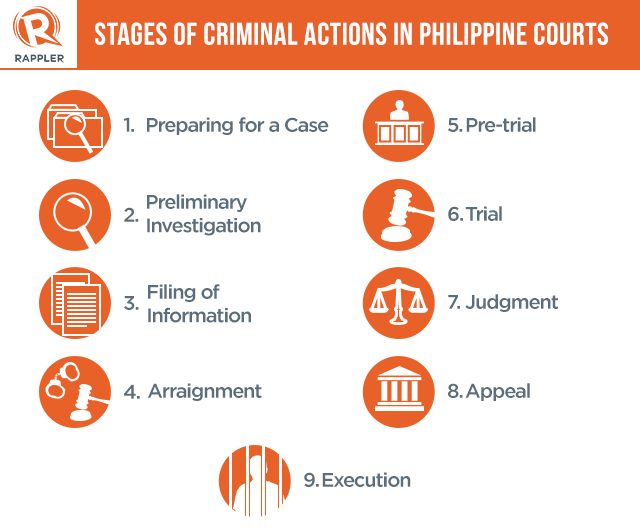SUMMARY
This is AI generated summarization, which may have errors. For context, always refer to the full article.

MANILA, Philippines – On Thursday, January 12, two years after charges were filed over the multibillion-peso pork barrel scam, the plunder trial of former senator Ramon “Bong” Revilla Jr was supposed to begin.
But it turned out that the Sandiganbayan had yet to issue a pre-trial order, which is a document required for the trial to proceed. The order contains facts and evidence, and both the prosecution and defense should stick to these throughout the trial.
There were discrepancies that needed to be corrected on the part of the prosecution, but lead prosecutor Joefferson Toribio claimed they weren’t informed ahead of time. Revilla’s lawyers hit the prosecution for delaying the trial, but they asked the justices nonetheless if they could also have more time to review the prosecution’s amendments.
And so what was scheduled for January 12 was reset to February 9.
The other two former senators accused of earning from the pork barrel scam are Jinggoy Estrada and Juan Ponce Enrile. Estrada’s graft and plunder cases and Enrile’s graft case are all in the pre-trial level.
Why are these cases taking so long?
Speedy Trial Act
In 1998, Congress passed Republic Act No. 8493 or the Speedy Trial Act, providing new procedural rules to “ensure a speedy trial of all criminal cases before the Sandiganbayan, Regional Trial Court, Metropolitan Trial Court, Municipal Trial Court and Municipal Circuit Trial Court.”
Following the passage of this law, pre-trials began to be conducted after arraignment. At this level, facts are stipulated, evidence of both parties are marked, and both prosecution and defense can object to the admissibility of evidence.
The logic behind it was so when the case reaches trial, it is already solid and concise, making it quicker for the courts to hear and resolve it.
A pre-trial agreement and conference will proceed before the court issues the pre-trial order which “shall bind the parties, limit the trial to matters not disposed of and control the course of action during the trial.”
The problem is that either of the parties can take their time with all of these, as there is no time limit set.
On Tuesday, January 10, former Philippine National Police (PNP) chief Alan Purisima went to the Sandiganbayan for the pre-trial of his graft case before the 6th Division, only for it to be postponed for another 3 months, to April 18, to be able to mark all documents.
Before any case reaches pre-trial, it goes through the judicial mills that can take years – two for the plunder cases over the pork barrel scam. (READ: Plunder cases: highs and lows)
Process

Here’s how it works:
1. Prepare the case
2. Preliminary investigation – This is where the prosecutor determines if there is probable cause and if there is, the information will be filed before the proper court, or for graft and plunder, the Sandiganbayan. (READ: What’s the difference: Plunder, graft in PDAF issue?)
3. Filing of information – Once the case has been filed with the Sandiganbayan, it will be raffled off to the judge who will hear the case. Once again, the court shall determine probable cause before an arrest warrant can be issued.
4. Arraignment – The accused shall be arraigned within 30 days from the date of the filing of information.
5. Pre-trial – Presentation of evidence, agreement, conference, and the issuance of the pre-trial order.
6. Trial – Once the case reaches trial, these are what can happen:
- After cross examinations and rebuttals and the prosecution has rested its case, the accused may file what is called a demurrer to evidence, which essentially means challenging the evidence presented by the prosecution. The defense will try to have the charges dismissed based on what they hope the court will find as weak evidence from the prosecution.
- The motion to file a demurrer shall be made within 5 days after the prosecution rests its case. The prosecution can oppose this motion within another 5 days. If the court grants the motion, the defense has another 10 days to file the demurrer, and the prosecution will have another 10 days to oppose the demurrer once they have received it.
7. Judgment – After the trial, the court shall promulgate its judgment after finding the accused guilty or not guilty. If the decision is acquittal, it cannot be appealed. If the accused is convicted, he or she has 15 days to file a motion for reconsideration or motion for new trial. One can only file a motion for new trial if new evidence has been found. The motion shall be decided within 30 days of submission.
8. Appeal – If the motion for reconsideration or motion for new trial is denied, the accused is given another 15 days to file an appeal before the Supreme Court.
And then the process begins again. (READ: Get to know the anti-graft court Sandiganbayan)
Time limits
The Speedy Trial Act provided new time limits for the procedures:
1. 6 months for trial – “In no case shall the entire trial period exceed 180 days from the first day of trial, except as otherwise authorized by the Chief Justice of the Supreme Court pursuant to Section 3, Rule 22 of the Rules of Court.”
2. 6 months for new trial – “The trial shall commence within 30 days from the date the order for a new trial becomes final, except that the court retrying the case may extend such period but in any case shall not exceed 180 days from the date the order for a new trial becomes final if unavailability of witnesses or other factors resulting from passage of time shall make trial within 30 days impractical.”
These time limits sound reasonable, except that the law also provided for several exclusions. There are several instances where the delays may not be counted into the time within which trial must begin:
(1) delay resulting from an examination of the accused, and hearing on his/her mental competency, or physical incapacity;
(2) delay resulting from trials with respect to charges against the accused;
(3) delay resulting from interlocutory appeals;
(4) delay resulting from hearings on pre-trial motions: provided, that the delay does not exceed 30 days;
(5) delay resulting from orders of inhibition, or proceedings relating to change of venue of cases or transfer from other courts;
(6) delay resulting from a finding of the existence of a valid prejudicial question; and
(7) delay reasonably attributable to any period, not to exceed 30 days, during which any proceeding concerning the accused is actually under advisement.
‘Snail-paced’ justice
Experts have pointed out that with the Philippines’ current judicial process, the accused in the pork barrel scam – who can afford top lawyers – will be able to avail of all legal remedies, and it could be another 10 years before any of the cases are resolved.
The Ombudsman and Sandiganbayan have a history of passing the buck when it comes to the delays in resolving cases.
In 2014, Sandiganbayan Presiding Justice Amparo Cabotaje-Tang said the Ombudsman has “inordinate delays” which, she said, were “deplorable” and “grossly offend the right of public justice.”
She cited a graft case against former Philippine National Bank-Cebu vice president Cayetano Tejano Jr which has been with the Ombudsman for over 22 years.
Former Ombudsman Simeon Marcelo answered back, saying the bottleneck was with the Sandiganbayan, and estimated that the anti-graft court takes an average of 10.2 years to process cases against government officials.
The Sandiganbayan managed to resolve or dispose only of 267 cases as of November 2015, compared to 430 cases in 2011, 363 in 2012, 480 in 2013, and 277 in 2014.
But Cabotaje-Tang said disposal data should not be the sole indicator of the Sandiganbayan’s overall performance. “The number of resolutions we issued in 2015 on pending incidents in various cases was more than 3 times the number of case disposal,” she explained.
For her part, Ombudsman Conchita Carpio-Morales registered a 74.5% conviction rate over a 5-year period, a dramatic increase from 33.3% before her term.
There are two bills pending in the Senate seeking to “fast-track the snail-pace disposition of cases in the country’s anti-graft court.” – Rappler.com
Add a comment
How does this make you feel?
There are no comments yet. Add your comment to start the conversation.